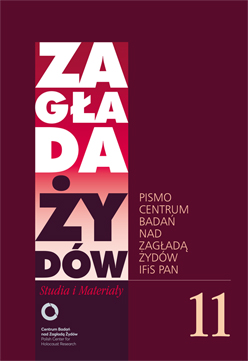Philip Friedman and the Beginning of Holocaust Studies
Zagłada Żydów. Studia i Materiały, No. 11 (2015), Pages: 235-251
Submission Date: 2020-10-21Publication Date: 2015-12-01
 https://doi.org/10.32927/ZZSiM.470
https://doi.org/10.32927/ZZSiM.470
Abstract
The article presents the scholarly achievements of Philip Friedman, an eminent historian from Lviv and survivor, whose wife and daughter died in the Holocaust. Friedman was a pioneer of Holocaust research. His contribution consisted in setting out research directions, developing the methodology and research tools, and documenting the Holocaust. Immediately after the war Friedman developed one of the first Holocaust research programmes, which included topics such as: the place of Jews in Nazi ideology, the subsequent stages of persecutions of Jews, the description of Jewish life and resistance to the Nazi extermination policy, the Nazi genocide, the attitude of the non-Jewish population toward persecutions of Jews, and the response of the free world, including the Yishuv, to the Holocaust. Friedman was convinced that reactions of the victims and their life in the shadow of looming annihilation should constitute the foundation of research on the ‘final solution’. The severely criticised the historians who based their Holocaust research solely on Nazi documentation, disregarding the Jewish perspective. Friedman himself was most interested in two issues: Judenrats and Jewish resistance. He examined the Jewish councils’ activity in the context of the inner life of ghettoes, the council’s influence on the life of ghetto inhabitants. Carrying out research on Jewish resistance, Friedman created a broad concept of that stance – one that included not only military activity but also acts in the spiritual and cultural sphere. Philip Friedman was also one of the first historians who paid attention to the universal significance of the Holocaust. He claimed that the human and moral implications of the ‘final solution’ pertained not only to the Jews but also to all mankind. He also assumed that Jews were the first but not the only victims of the Nazi extermination policy, as he discussed the extermination of the Roma as early as in 1950.
License
Copyright (c) 2015 Author & "Holocaust Studies and Materials"

This work is licensed under a Creative Commons Attribution 4.0 International License.
https://creativecommons.org/licenses/by/4.0
Similar Articles
- Dan Michman, Dutch Society and the Jewish Fate: A Puzzling Record , Zagłada Żydów. Studia i Materiały: No. 12 (2016)
- Jacek Leociak, Understanding the Holocaust. A Task for Generations , Zagłada Żydów. Studia i Materiały: 2008: Holocaust Studies and Materials
- Jacek Leociak, Literature of the Personal Document as a Source in Holocaust Research (a Methodological Reconnaissance). , Zagłada Żydów. Studia i Materiały: 2008: Holocaust Studies and Materials
- Jacek Leociak, Marta Tomczok, Affective Holocaust Kitsch – Introduction , Zagłada Żydów. Studia i Materiały: No. 17 (2021)
- Anna Abakunkova, Contemporary Holocaust Studies in Ukraine , Zagłada Żydów. Studia i Materiały: No. 10 (2014)
- Bartłomiej Krupa, Critical History and its “Shadow Cabinet.” Polish historiography on the Holocaust during 2003–2013 , Zagłada Żydów. Studia i Materiały: No. 10 (2014)
- Bartłomiej Krupa, Critical History and its ‘Shadow Cabinet’. Polish Historiography and the Holocaust during 2003–2013 , Zagłada Żydów. Studia i Materiały: No. Holocaust Studies and Materials (2017)
- Joanna Śliwa, A reviev: Agnieszka Witkowska-Krych, Dziecko wobec Zagłady. Instytucjonalna opieka nad sierotami w getcie warszawskim , Zagłada Żydów. Studia i Materiały: No. 19 (2023)
- Editors Journal, Jan Grabowski, From the editors , Zagłada Żydów. Studia i Materiały: 2010: Holocaust Studies and Materials
- Jan Grabowski, Editors, From the editor , Zagłada Żydów. Studia i Materiały: 2008: Holocaust Studies and Materials
1 2 3 4 5 6 7 8 9 10 11 12 13 14 15 16 17 18 19 20 21 22 23 24 25 26 27 28 29 30 31 32 33 34 35 36 37 38 39 40 41 42 43 44 45 46 47 48 49 50 > >>
You may also start an advanced similarity search for this article.
 English
English
 Język Polski
Język Polski



 https://orcid.org/0000-0002-2795-2154
https://orcid.org/0000-0002-2795-2154





